Return to the Stevens Family
Homepage
Back to the Caving page
Related
account:
Walk
to Selma Plateau from Umq, with a visit to the top of the Majlis
 |
Descent into Majlis Al Jin
By Vance Stevens
Oman, Nov. 3, 1994
[This is condensed slightly from an original I wrote shortly
after the actual event. In the original, I tried to capture as much as possible
the sensations of fear and accomplishment which I realized were waning quickly
as the feat regressed. It is interesting to me how the human psyche deals with
fear, but some of those immediate recollections seem a bit verbose to me now,
so those are the parts where I did the most editing. Now that I've had more
experience on rope, some of what I've written here seems almost embarrassing,
I've since been down for a second descent/ascent (June 28, 2001), but I've
tried to preserve the flavor of the first-time experience. All but two of the
photos below were taken by Arthur Gregory on a visit to the area in Dec. 2000,
used with his permission]
GPS: UTM/UPS Oman datum
40 Q 0715608
UTM:
2531708
Introduction
Majlis Al Jinn is the second largest cave chamber in the world.
The three openings in its towering roof, the only ways in or out, resulted from
cave-ins of the karst limestone rock forming the ceiling of the chamber, and
the two largest of these have left rubble and boulders piled on the floor of
two corners of the chamber, too far down to be seen from above. The third
opening is a small fracture in the limestone roof of the cave forming a chimney
about 5-6 meters across and 15 meters deep. From the top of the chimney, the
chamber plunges 178 meters through awesome spaciousness to the dusty floor
below.
Picture credit left, Frans, Jan. 28, 2001
(me on the left, topside) |
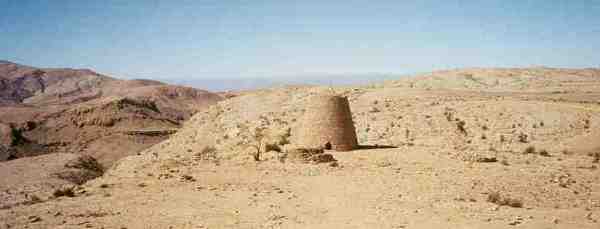
Some recent discoveries
Majlis Al Jinn is one of several sink holes at 1200-1400 meters altitude
in the Jebel Bani Jaber mountains between wadis Shab and Nam in Oman. This
fascinating area is the site of many recent discoveries. Majlis Al Jinn itself
was discovered in 1983 by Don Davidson, a geologist who was for fifteen years
on the payroll of the Omani government for work entailing tasks as onerous as
hiking, exploring, and abseiling.
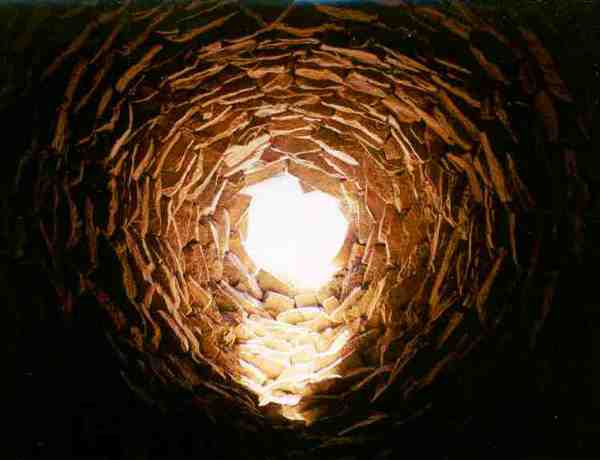
As recently as 1991, a dozen impressive 3000 year-old bronze-age tombs
were discovered nearby. Standing like sentinels along a ridge overlooking
rippling folds of rockscape, the tombs were built from chunks of limestone that
litter the land. The rough-hewn stones were cleverly stacked to form a domed
chamber surmounted by a chimney. The best examples stand some 1ten meters tall,
with the outer layers of rock remarkably well coined. The inner layers are not
coined, and the rough surfaces can be climbed only with difficulty, as they
slope inward to form the chimney. The climber, pulling him or herself up from
rock to rock, cannot help but be impressed at the structural integrity of the
tombs, whose builders carefully set each unmortared stone in place, preventing
for millennia the collapse that would ensue if any stones could be dislodged by
the climber.
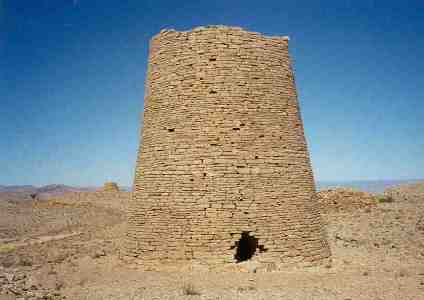
The tombs can be reached by a new dirt road bulldozed out of the
escarpment. The trip takes 4 to 6 hours from Muscat, depending on driving day
or night and condition of the road. The last set of tombs occupies a spot of
level ground with a panoramic view which, despite the chill wind at that
altitude, is much favored by campers, as there is no suitable spot for camping
in the inhospitable terrain between there and the jumping off point for the
Majlis area, ten kilometers away, at the end of a tortuous road leading to a
village whose inhabitants migrate summers, leaving their village eerily
deserted, except for flies and hornets. People visiting the tombs often drive
to the village and hike into the sink hole area from the end of the road.
Majlis Al Jinn itself was mentioned in a recent issue of Oman Today,
but because the article failed to give instructions on how to find it, few who
come this far reach that particular spot. Still, it shouldn't be that difficult
to find. Basically, you go north, heading into the wadi where you have left
your car. After only ten minutes walking, in order to continue north, you have
to climb up the hill at the end of the wadi. If you're sharp-eyed, you'll find
a faint trail leading up the rocks. From the top, you see a level plain further
north. The trail to the left leads to the plain, but either direction going
north will get you there.
After crossing a series of rock-strewn wadis fairly typical of Oman, you
descend into the plain, where you can easily see white stones marking a runway
that must have served earlier geological expeditions. Here, it is a relief to
walk for a few minutes on smooth ground, unhindered by boulders. A well-trod
trail continues north, perpendicular to the head of the runway. From this area,
you can see a mushroom-shaped tree atop a ridge, again to the north, and Majlis
Al Jinn is right there, just to the north of that. It will take you about an
hour to walk there from the airfield.
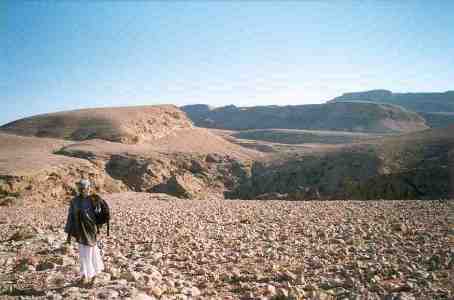
There are other sink holes in the area. To your left from the runway,
you can see the rustic stone houses of a village that might be deserted, and a
line of trees leading there whose roots reach into the floor of a wadi where
the boulders have been shaped over the eons by rare instances of flowing water
-- incongruously, considering the thirst you can develop in the crisp sunshine,
whose effect is only slightly attenuated by the altitude. A 15-minute walk up
this wadi will take you to a gaping sink hole.
But skip that for now, and continue north on your way to Majlis Al
Jinn. Back on rough rock terrain, you round a hill and keep your eyes peeled to
the right, where you might notice a second sink hole a half hour ahead, a
massive pit with a seemingly bottomless cave at one end, a foreboding place
with sheer drops.
By now you will have lost sight of your mushroom-shaped tree, but barely
discernable trails will lead you to it, or if you lose those, you can just head
north, or slightly left of north, about 330-350 degrees. About two hours out
from your cars, if you are on target, you should find yourself making your way
up a slight incline, a dozen or so trees lining a wadi just to your right.
Ahead of you is your mushroom-shaped tree, and beyond that is a group of
shorter trees with three stems close together.

Near there, you should have no trouble finding the two largest openings
into the cave. From the easternmost opening, you can see a hut set into a
crevice on a nearby rock face. Opposite the hut is a grove of trees, a good
place to camp, and just up from that as you go away from the hut is a smaller,
narrow crevice about ten meters long below which is the sheer drop of 178
meters through the shell of earth you are walking on. This is the chimney over
the center of Majlis Al Jinn. It's the longest way down into the cave chamber;
in fact, it's the longest natural free-drop abseil to be found anywhere in
Oman. The coordinates at this spot are 715.630 and 2531.710 on the Ministry of
Defense map of Tiwi produced by Hunting Services Ltd, 1984, in case you've
brought along one of those.
Instinct will warn you to be careful around all these openings. They are
all sheer drops. The bones of small goats scattered on the floor between
150-180 meters below attest to the danger to those whose instinct is less well
formed. From these openings, you can see only the sides of the chasm where they
are lit by shafts of light from the sun; cloaked in mysterious, seemingly
impenetrable darkness are the floor of the cave far below, hiding from hikers
the bones and piles of rubble of earth which at one time gave way near where
you are standing and walking about with such naive confidence.
All around these openings, below you, the limestone is cracked and
fissured and forms the ceiling to a geological phenomenon whose scale and
dimension are hard to explain or imagine. When you peer into the darkness from
the openings above, you have no more hope of grasping what lies below than a
seaman peering into the ocean has of fathoming the scope of life and depth
between his ship and the ocean floor. Fortunately, the ceiling on which you
tread has structural integrity not unlike that of the chimney-shaped tombs at
your campsite the evening before.
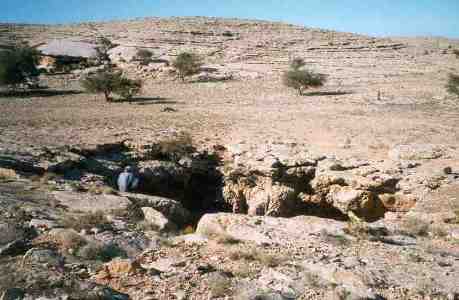
Perhaps a better analogy for what holds the roof over Majlis Al Jinn in
place is a gothic cathedral. Imagine the largest gothic cathedral you can, with
stones set into flying buttresses in such a way that each supports the other, a
fact that can be appreciated by standing on the floor of such a cathedral and
looking up at the ceiling towering overhead, and being thankful that whatever
is supporting those stones, they are not falling down on you, nor have they
fallen on anyone for centuries. But to appreciate the scale of Majlis Al Jinn,
one has to think bigger than a cathedral. With only slight alteration, you
could fit the Great Pyramid of Giza inside the Majlis. The pyramid is short
enough to fit, only 147 meters, but its base is 236 meters, about the same as
Majlis Al Jinn, whose immense floor measures 225 by 300. I'm not sure how high
the Astrodome in Houston is, but its dome measures 195 meters at its base, so
it may be a comparable, if slightly smaller, structure. If you've ever climbed
or taken an elevator halfway up the Eiffel Tower and verged on vertigo while
enjoying the panoramic views of Paris, then you might have been at around 178
meters, because the Eiffel Tower is 400 meters tall, including its antenna. The
drop into Majlis Al Jinn covers approximately half the height of the Empire
State Building in New York City, which stands at 381 meters tall.
Now imagine that there is someone on the roof of that improbably vast
cathedral removing stones so that far above you can see a small hole in the
ceiling and blue sky overhead. In that hole, you see the figure of a man who
has just dropped a 200 meter rope 9 mm thick down the opening and is now
abseiling toward you. At first he looks like a skydiver, a small dot overhead
that gradually gets larger until gradually you can make out more defined
features. But a skydiver falling at terminal velocity from 3000 meters falls
for only a minute before opening his chute and drifting to earth. The abseiler
might take six to eight minutes to descend from the top of Majlis Al Jinn.
Depending on where you are in the cathedral, he might appear as a spider
suspended above you and growing gradually larger and more distinct, or, in case
he is not directly overhead, as a figure disembodied, suspended in space,
drifting slowly earthward. As he descends, he takes on form, but there is no
reference to fix his position until he nears the ground, and then he appears to
land like a parachutist. But unlike a chutist, or a visitor to a cathedral, the
abseiler in Majlis Al Jinn has no way out but the way he came, back up the rope
extending 178 meters overhead. The earthbound have no way of appreciating the
thrill of a descent into such an abyss or, more chilling, the return trip.
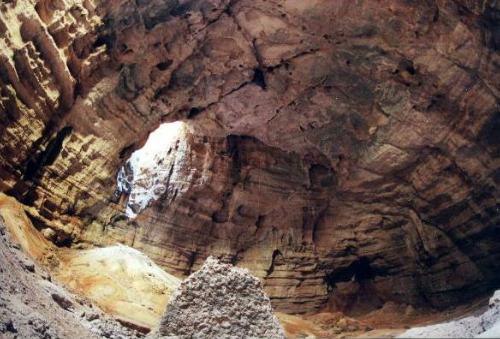
This picture and the one following were
made by Patrick van Daele on a trip in October 2000 and are included here with
his kind permission.
These pictures have a story. On a trip that I made with
Patrick, Erik Kleiss, and Dave Butcher to Selma Plateau January 18-19, 2001,
walking up from Umq, we met the shepherd who lives with his wives and young son
in the rough houses near the entry to the Majlis cave. The shepherd's name is
Sobha Rashid, and he can be recognized because one eye is lame with traucoma.
His son goes to school in Fins, and the son told me that Sobha Rashid would
walk him down there at the beginning of each week, and that he would return on
weekends (an all day trip I imagine, despite the natives' penchant for
hyperbole when reporting times on the prodigial distances covered). Sobha
Rashid went well out of his way to show our group not only the trail down the
mountain, but to take us to an outcrop first where we could see where it was we
were going. Sobha Rashid said to us that as long as he had lived above that
cave, he had no idea what was inside it, and he would very much appreciate a
picture of the interior. So, if you're going that way, please print copies of
Patrick's pictures here and below and take them with you and give them to the
shepherds at the entrance to be handed to Sobha Rashid, if he isn't there
himself.
Getting down
Although few would attempt Majlis Al Jinn without proper training and
experience, even serious abseilers are unprepared for the descent into such an
incredible spaciousness. The dimensions are other-worldly. Dropping out of the
chimney and into the cavernous chamber is like breaking through the clouds of
Venus to find yourself plummeting toward a planet far below. Perspective is
skewed to such a point that it nearly overcomes fear.
I was third down in my group of four: Cemal (crazy but competent Brit
with a Turkish father), Frank (young, collected, from Holland), me, and finally
Eric (another Dutchman, experienced caver). The rope was secured from three
rock anchors all lined up so as to minimize effects from shock impact should
any give, and backed up by a similarly balanced rope system connected to three
boulders. The rope itself, whose ten kg weight I had shouldered on the trek
out, was designed to withstand 2000 kg. To relieve its rubbing on rocks, it was
held out from the near wall of the chimney by a sling anchored in the opposite
wall with two carabiners just a few meters below the launching point. Each of
us in our party lowered ourselves there with a backup belay, at which point we
had to stop to unclip the sling and reclip it above the abseiling device before
releasing the belay and beginning our drop freely on our own.
I was using a stop, a descender with a handle that was pulled to allow
descent and released to stop it. I spend the first few meters of my fall making
sure I could control it, and then I held down the handle and slipped through
the chimney.
Dropping in the relative darkness of the chimney with walls close
around, one feels secure. From inside the chimney, the floor of Majlis Al Jinn
is visible as earth viewed through the porthole of an airplane. From an
airplane, it is impossible to appreciate height. Changes in altitude of a few
hundred meters will be imperceptible to a passenger on the plane. Viewing the
bottom of Majlis Al Jinn on the way down through the chimney, altitude is
similarly abstract. It is not until passing into the chamber, when the walls
suddenly vanish to 150 meters away on all sides, that a sense of height hits
you. I don't think anyone can describe that moment of entry into the chamber
from so high up because no one can be prepared for it. It is at that moment
that one is first aware of the scope of Majlis Al Jinn, and that scope is
unlike anything one has experienced before.
Dropping out the chimney was like passing through the roof of that
imaginary cathedral, except that I have never seen a cathedral that big. Like a
cathedral illuminated by its stained-glass windows, the chamber is bathed in
light from its two major openings, so its grandeur is at once entirely visible.
Strangely, the ceiling regresses quickly while the ground appears to get no
nearer. Incredibly, the abseiler has several minutes to consider the
predicament, before things on the ground begin to come into focus. One
sensation is silence. Except for the constant swish of the rope passing through
the descender, there is no sound, unless one thinks to let out a shout and hear
it echo all around. Another sensation is smell - the descender is heating
rapidly and smells like an overheated car engine. I try to slow it down, but
obviously, I want rope to pass through it so that no bit of nylon comes in
contact with hot metal for more than a fraction of an instant. Faith in
equipment overcomes momentary fear of death, as I reassure myself that surely
this device must have been designed with components that withstand heat. If
not, it's too late to write a letter.
Just then I notice that a small speck below has moved. Now it's calling
up in words that echo incomprehensibly with too much reverb. Can this be Frank
or Cemal, looking the size of a small insect on the floor far below? It's the
first indication I have of how high I really am and how long it's taking to get
down, and it's the first moment that fear kicks in. It's a sickly,
how-did-I-get-myself-into-this-mess kind of fear, that is starting to encroach
on euphoric excitement. Part of me wants to slow up and savor this incredible
experience and the other part wants to get the hell down and get it over with
because I'm starting to think how hopelessly painful a fall from that altitude
would be. I shove that thought out of my mind. It's only one aspect of a
melange of awe, raw fear, and joy that make me finally hit rocky ground with
relief and disappointment both vying for supremacy as I stumble over myself to
unhook and complete my safe landing.
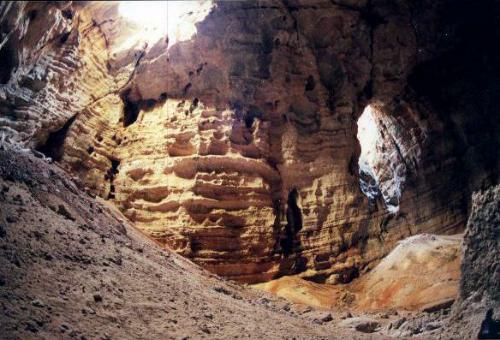
Picture credit, Patrick van Daele, October
2000
Getting out
Later on, by the fire that night, Jeff told us, as long as we were all
confessing how scared we were, why he didn't repeat the adventure he himself
had experienced just a few weeks before (Jeff had guided us in, and had acted
as our topside support). He said, "When you first go in, you think to yourself,
'Wow, I'm really dropping myself into something neat here!' when really what
you've done is you've dropped yourself into some really deep shit, and you're
just beginning to realize it, because now what you've got to do is get yourself
out." And we shared his sardonic laughter, as we understood by then how the
joke had been on us. It was to avoid reenacting that moment of nail-biting
realization that Jeff had brought us out to experience the thrill but had
passed on repeating it himself. And that's hitting the nail on the head,
because having been utterly unprepared for what 178 meters means in abseiling
terms, you are now forced to deal with what that means you have to do to get
back out.
If you experienced fear coming in, it was over in a matter of minutes.
Going back, you're going to be alone on a thread from which your life will be
suspended for a whole hour, if you do the job properly. If not, well, let's
change the subject, shall we?
Cemal was first off. It was 2:00 p.m. before he started up, tediously
slow. His ascender had not been strapped close enough to his chest causing him
to drag rope with him when he ascended so that he dropped back down some with
every upward thrust, and his leg slings weren't inside his harness, so he was
kicking at an angle rather than straight down, which meant that energy for
going up was being dissipated sideways. Most disconcerting was the way the
supposedly static rope reacted to each kick and pull by bouncing him up and
down like a yo-yo, an effect due mainly to the rope's great length (that
stretch would theoretically become negligible nearer the top). Watching him
sweat for every inch of upward motion was disheartening, as he was one of the
most experienced in the group. To me, contemplating my own first-time jumar
ascent over such a great distance, Cemal's painstaking progress was a
revelatory example. In all, it took him an hour and ten minutes to reach the
top.
During that time, Frank and I wandered the floor of the cave, examining
the interesting creations of nature, the stalactites and stalagmites, the
drapery effects of water trickling down limestone, and the smooth brown mounds
directly under drips from the ceiling.
Optical illusions induced by the scale of the cave awed us with every
step. Just 20 or 30 meters away from it , the rope itself became invisible,
lost in the expanse of the cave, and Cemal appeared as a figure hovering
overhead. With every step that Frank and I took in any direction, Cemal's
position with respect to features in the walls and ceiling changed so that
whenever we'd turn to check on him, it took us a minute to locate him. From one
such moment to the next, his position was impossible to predict. Often we'd
look for him higher than he was and then locate him only halfway up the rope,
or a third, or whatever -- even how far up was difficult to tell. He might as
well have been a bat flitting overhead, and just as difficult to spot against
the pocked backdrop. Sound was no help, as his distant grunts of exertion broke
the silence with echos coming from all directions at once. Resting, he would
blend in with one of the holes on the ceiling, until one of the holes would
suddenly move. Like a shooting star, if you happened to be looking in the right
direction at that moment he kicked, then you had a fix on him and could follow
his progress as long as you didn't look away. As he neared the ceiling, he
seemed so dizzyingly high up that it was hard to imagine his feelings, whether
of fear or elation. I couldn't avoid worrying how I would soon be managing
myself in the same situation. Conversation with Frank, utterances such as,
"Man, it's taking him forever ...", or "At least we may both get to do this in
daylight ..." revealed that we shared the same concerns.
Frank and I were on top of one of the piles of rubble, a small 20
meter-high mountain at the base of a 130 meter vertical cliff below one of the
skylights in the roof, when Cemal disappeared into the chimney, and then we
marked his progress only by the oscillation on the rope showing that he was
still on it. When the rope went limp, we didn't know what to expect. It was
getting too late to send the fourth man in and get him out again before dark,
but they had to replace my harness which Cemal had taken in preference to the
one he had initially attempted to jury-rig. Eventually the rope wiggled again
and then stopped. Obviously someone had descended to the clip-in point, but
whether to clip himself through or send down the chest-harness on a carabiner,
we didn't know right away.
After a long hesitation, the rope resumed its oscillation, and then Eric
appeared as a speck beneath the chimney descending deliberately toward us. We
savored his long flight, reliving our own. When he landed, he produced a
back-pack full of goodies, including some granola bars to relieve our neglect
of food. Suddenly he recoiled sharply. The pair of figure-8's that had just
taken the friction of 180 meters of rope passing rapidly through had dangled
against his fly and burned a sensitive spot beneath his jeans. Gingerly, he
unclipped the offending metal and laid it on a rock to cool.
Frank's ascent went better than Cemal's. Though it was still slow, it
took less than an hour in all. Perhaps because he'd had more time to think
through the distribution of the various crabs and slings that would assist his
ascent, he had a flawless take-off. From above, he asked only that we hold the
rope at the bottom before its weight would pull it down through the ratcheted
ascender the higher he got. Watching him go up with relative ease restored
somewhat my confidence in getting out of there.
The light in the cave was getting noticeably dim while Eric and I
wandered about, glancing up at Frank now and then as Frank and I had checked on
Cemal an hour earlier. Frank had begun his ascent at 3:40 and if all went well
there was some hope that I would be out myself in daylight.
My turn came almost two quickly. Once Frank had left the rope limp, I
started cranking the elasticity out of the static rope. At ten to five, I was
on my way up. The jumar (which they call a "frog" in the states; where "abseil"
is the same as "rappel") works with two ascenders, each with a cam that allows
the rope to pass one way through it but locks against its slightest movement
the wrong way. The main load bearing ascender is fixed just below the chest,
and the object is to work this one gradually up the rope. This is done by means
of the second ascender, to which is attached the pair of stirrups. The climber
brings his legs up underneath while pushing the second ascender as far overhead
as possible. Straightening the legs then brings the chest ascender up the rope
where it locks in its new position. Movement up the rope is thus accomplished
through a series of crouching, pushing, and straightening motions which, when
kept up over an hour, are wearing but not strenuous, and get you out of the
hole you're in.
The time that was for me most interminable on the rope was when I was
about halfway up it. The floor and roof of Majlis Al Jinn are so massive that
neither offer much sense of distance. That was an advantage with regard to the
floor, as it reduced the sense of being high off it, but discouraging in the
case of the ceiling, which never seemed to get any nearer. I could mark
progress only by reference to the walls, which I started to notice well before
I had climbed halfway. By this reference, progress was painstakingly slow.
Eventually, I became aware that the ceiling was getting nearer. One of
my companions confessed that this was for him the most difficult time, when he
knew he was highest up, but for me it was the most reassuring. For me, unreal
space and lack of reference was the greatest problem, and with the ceiling
drawing near, I finally had a marker of progress and allowed myself a second
wind. Enthusiastically I lifted myself into the chimney and saw not far below
the sling which held the rope off the wall a belay which I managed to reach in
minutes. As I hooked into it, my wife and friends called down reassuringly. The
moment I hooked myself into security, memories of the raw fear I had just
experienced passed into relief and the euphoria of accomplishment, so that now
it takes a conscientious effort to recall the fear at all.
Coincidentally, as I was completing my climb, a party of hikers passed
by on their way from Umq to Fins. I knew most of them as they were friends in
running. One of them asked me how I had enjoyed the ascent. "It scared the shit
out of me," I said, off the top of my head "but on the other hand, it's not
every day you are treated to the pleasure of having the shit scared out of
you." My friend, a Majlis veteran himself, nodded knowingly.
Anyway, my climb was nothing compared to Eric's. Eric had to make his
way out in the dark.
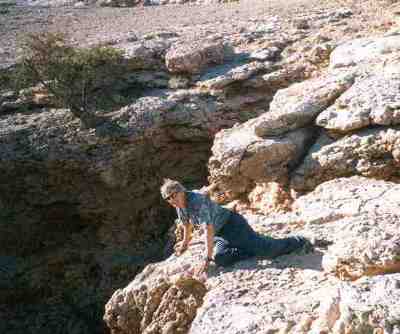
Thanks, Greg, for the use of your
pictures!
A footnote: on returning to the floor of Majlis al Jin
my second time, June 28, 2001, I noticed in the book at the bottom that I had
recorded incorrectly the date of our descent. In case you're there, you'll find
that I've dated our descent 11/7, not the 3rd, which is when we really did the
deed. Ma'alesh, as we say.
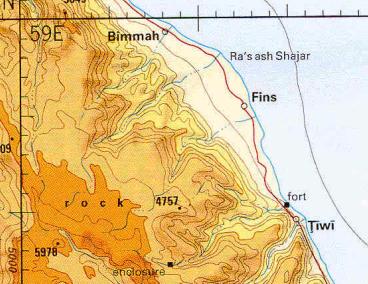
|

|

Use the
navigation at the top of this
page or your browser's BACK button to
return to a previous page
For comments, suggestions, or further information
on this page,
contact Vance Stevens, page
author and webmaster.
Last updated: August 31, 2001 in Hot
Metal Pro 6.0 |











